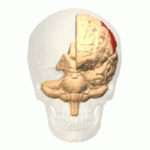頂葉
頂葉(粵拼:deng2 jip6;英文:parietal lobe,嚟自拉丁文「paries-」,即係拉丁文入面「牆」噉解)係哺乳類動物嘅四大腦葉其中一塊。頂葉位於額葉(frontal lobe)同中央溝(central sulcus)後面,顳葉(temporal lobe)嘅上面,係腦葉當中最近頭殼頂嘅[1][2]。
| 頂葉 | |
|---|---|
 一個人類左腦嘅立體想像圖; 紅色嗰笪係頂葉。 | |
| 生理 | |
| 屬於 | cerebral hemisphere[*] |
| 識別碼 | |
| UBERON ID | 0001872 |
| TA | A14.1.09.123 |
[改維基數據] | |
頂葉做好多同觸覺相關嘅功能:佢入面嗰塊體覺皮質區(somatosensory cortex)對於處理觸覺資訊嚟講好緊要[3]-體覺皮質區嘅每一橛都負責處理身體某一個部份嘅觸覺資訊,而人類嘅體覺皮質區當中處理手部同口部觸覺資訊嗰兩笪零舍大,噉即係話人腦特別重視處理手部同口部相關嘅嘢-人腦對口部體覺資訊嘅運用亦都同語言嘅使用有關[4]。
除此之外,頂葉仲會負責做感官資訊嘅綜合處理,由丘腦(thalamus)嗰度接收唔同感官(眼耳口鼻等)俾嘅資訊,再將呢啲唔同感官嘅資訊結合埋一齊,令隻動物曉綜合性噉了解佢四周圍嘅環境[2]-例如係隻動物喺探索自己周圍環境嗰陣時,佢要用本體感覺(proprioception;指隻動物對自己身體各部份係乜嘢位置嘅認知)嗰度嚟嘅資訊,跟手再將呢啲資訊同視覺所俾嘅資訊結合埋一齊,靠噉嚟了解自己喺個環境入面處於乜嘢位置。
結構
編輯邊界
編輯頂葉嘅邊界由三條溝界定[1]:中央溝(central sulcus)係將額葉同頂葉分開嗰條溝;頭頂後頭溝(parieto-occipital sulcus)係將頂葉同枕葉(occipital lobe)分開嗰條溝;而外側溝(lateral sulcus)就係將頂葉同顳葉(temporal lobe)分開嗰一條溝。喺呢三條溝之間嘅大腦皮層區域就係所謂嘅頂葉。通過成塊大腦皮層、將左右腦分開嘅中央縱裂(longitudinal fissure)亦都通過頂葉,將佢分開咗做左右兩邊,每一邊嘅體覺皮質區會負責處理身體相反嗰邊嘅體覺資訊。
細分區
編輯喺中央溝後側,頂葉最前側嗰度嘅就係所謂嘅中央後回(postcentral gyrus,又叫「Brodmann area 3」),係主要體覺皮質區。中央後溝(postcentral sulcus)將主要體覺皮質區同頂葉後側啲嘅部份分開。
頂葉嘅後側腦區可以再細分做上頂小葉(superior parietal lobule,Brodmann areas 5 & 7)同埋下頂小葉(inferior parietal lobule,Brodmann 39 & 40),而呢兩個子區域由頭頂間溝(intraparietal sulcus,簡稱「IPS」)分隔開。頭頂間溝同佢四周圍嗰啲腦回對於引導四肢同眼嘅郁動嚟講好緊要。
功能
編輯概論
編輯頂葉最重要嘅功能包括咗觸覺資訊嘅處理[5]、將身體唔同部份嘅感官資訊結合埋一齊、對數字嘅認知、同埋對物件嘅操控[6]。頂葉比較後側嘅部份會幫手做視覺方面嘅資訊處理(雖然視覺處理主要係枕葉做嘅工作),會接收空間視覺(「where」)同埋行動視覺(「how」)嘅資訊,並且運用呢啲資訊,再加埋體覺資訊,嚟到幫手控制手同眼嘅郁動[7][8][9]。研究視覺方面嘅現象嘅神經科學家同心理學家好多時會將頂葉後側形容為「視覺背側流」(dorsal stream of vision)[10]-相對於喺正頂葉後側嘅枕葉。
獼猴研究
編輯喺 1990 年代,有科學家做咗一系列研究,用獼猴做對象嚟研究頂葉嘅功能。佢哋嘅主要發現如下:
- 外側頭頂間區(lateral intraparietal area,LIP)內有一柞神經細胞好似地圖噉代表空間入面唔同位置嘅顯著性(saliency)-即係話每一粒神經細胞嘅啟動程度代表咗空間入面某一個特定位置嘅資訊對隻動物嚟講有幾緊要[11],亦都能夠預測隻動物會擺幾多注意力落去嗰個位置入面。呢啲活動仲能夠攞嚟預測隻動物嘅眼郁動[12]。
- 腹側頭頂間區(ventral intraparietal area,VIP)會由多種感官(包括視覺、體覺、聽覺、同前庭系統呀噉)嗰度接收資訊[13]。有觸覺感受野嘅神經細胞會用一個以個頭做中心嘅坐標系統代表個頭周圍嘅空間[13]。有視覺感受野嗰啲細胞都會以噉樣嘅參考系傳資訊[14]。
- 內側頭頂間區(medial intraparietal area,MIP)嘅神經細胞會用一個以個鼻做中心嘅坐標系統傳達要攞嘅物件嘅位置[15]。
- 前側頭頂間區(anterior intraparietal area,AIP)內有啲特殊神經細胞,呢啲神經細胞會對要攞嘅物體嘅形狀、大細、同方向有反應,亦都會反映要點樣控制對手[16][17]。呢啲神經細胞會向啲同身體運動有關嘅腦區射訊號,並且指揮佢哋控制手嘅郁動[7]。
廿一世紀嘅功能性磁振造影(fMRI)顯示,人類嘅頭頂間區喺功能同獼猴嘅相似[18]。人類嘅「頂葉眼野」(parietal eye field)同「頂葉延伸區」(parietal reach region)大致上等如馬騮嘅 LIP 同 MIP,而且似乎都會運用以自身嘅眼做中心嘅坐標系統[19]。另一方面,左右腦嘅頂葉系統同一個人有幾傾向靈性有相關[20]。
臨床研究
編輯病變研究
編輯神經科學家好興研究病變:睇吓腦部唔同地方受損嘅病人喺行為同認知上有乜嘢缺失,再憑呢啲觀察推測受損咗嗰啲腦區所做嘅係乜嘢功能。根據呢啲研究,頂葉病變可以有以下呢啲症狀(亦都要視乎受損嘅係頂葉嘅邊一忽):
- 如果受損嘅係左右腦頂葉是但一邊嘅話
- 另一邊身體嘅感官會失靈,例如係半側空間無視(hemispatial neglect)噉,就涉及(例如)個病人其中一邊眼明明睇到某件物體,但係都唔識俾反應[21][22];
- 喪失憑觸覺判斷物體形狀嘅能力(astereognosis);
- 做唔到合埋眼判斷人哋喺自己手掌上面寫咗乜嘢字(agraphaesthesia);
- 感官腦癇(sensory seizure);
- 唔平衡嘅視動反應。
- 如果受損嘅係左右腦頂葉當中比較強嗰一方嘅話
- 失語症(aphasia),指理解同運用語言上有困難;
- 失讀症(dyslexia),指讀文字上有困難;
- 失行症(apraxia),指雖然小腦同肌肉等嘅結構冇問題,但喺執行複雜運動控制上有困難[23][24];
- 失認症(agnosia),指唔曉辨認某啲感官刺激。
- 如果受損嘅係左右腦頂葉當中冇噉強嗰一方嘅話
- 失去空間感;
- 唔識複製人哋畫嘅嘢;
- 唔識著衫,或者著得唔啱;
- 病覺缺失症(anosognosia),唔知自己有病。
睇埋
編輯攷
編輯- ↑ 1.0 1.1 Carpenter, Malcolm (1985). Core text of neuroanatomy (3rd ed.). Williams & Wilkins.
- ↑ 2.0 2.1 Parietal Lobes of the Brain. ThoughtCo.
- ↑ Van der Loos, H., & Woolsey, T. A. (1973). Somatosensory cortex: structural alterations following early injury to sense organs. Science, 179(4071), 395-398.
- ↑ Ito, T., Tiede, M., & Ostry, D. J. (2009). Somatosensory function in speech perception. Proceedings of the National Academy of Sciences, 106(4), 1245-1248.
- ↑ Penfield, W., & Rasmussen, T. (1950). The cerebral cortex of a man: A clinical study of localization of function. New York: Macmillan.
- ↑ Blakemore & Frith (2005). The Learning Brain. Blackwell Publishing.
- ↑ 7.0 7.1 Fogassi L, Luppino G. (2005).Motor functions of the parietal lobe. Current Opinion in Neurobiology, 15:626-631.
- ↑ Mishkin M, Ungerleider LG. (1982) Contribution of striate inputs to the visuospatial functions of parieto-preoccipital cortex in monkeys. Behav Brain Res. 1982 Sep; 6(1): 57-77.
- ↑ Goodale MA, Milner AD. Separate visual pathways for perception and action. Trends Neurosci. 1992 Jan;15(1): 20-5.
- ↑ Hebart, M. N., & Hesselmann, G. (2012). What visual information is processed in the human dorsal stream?. Journal of Neuroscience, 32(24), 8107-8109.
- ↑ Kusunoki M, Goldberg ME (March 2003). "The time course of perisaccadic receptive field shifts in the lateral intraparietal area of the monkey". J. Neurophysiol. 89 (3): 1519–27.
- ↑ Goldberg ME, Bisley JW, Powell KD, Gottlieb J (2006). "Saccades, salience and attention: the role of the lateral intraparietal area in visual behavior". Prog. Brain Res. Progress in Brain Research. 155: 157–75.
- ↑ 13.0 13.1 Avillac M, Deneve S, Olivier E, Pouget A, Duhamel JR (2005). "Reference frames for representing visual and tactile locations in parietal cortex". Nat Neurosci. 8 (7): 941–9.
- ↑ Zhang T, Heuer HW, Britten KH (2004). "Parietal area VIP neuronal responses to heading stimuli are encoded in head-centered coordinates". Neuron. 42 (6): 993–1001.
- ↑ Pesaran B, Nelson MJ, Andersen RA (2006). "Dorsal premotor neurons encode the relative position of the foot, eye, and goal during reach planning". Neuron. 51 (1): 125–34.
- ↑ Murata A, Gallese V, Luppino G, Kaseda M, Sakata H (May 2000). "Selectivity for the shape, size, and orientation of objects for grasping in neurons of monkey parietal area AIP". J. Neurophysiol. 83 (5): 2580–601.
- ↑ Murata A, Gallese V, Kaseda M, Sakata H (May 1996). "Parietal neurons related to memory-guided hand manipulation". J. Neurophysiol. 75 (5): 2180–6.
- ↑ Culham JC, Valyear KF (2006). "Human parietal cortex in action". Curr Opin Neurobiol. 16 (2): 205–12.
- ↑ Medendorp WP, Goltz HC, Vilis T, Crawford JD. (2003) Gaze-centered updating of visual space in human parietal cortex. J Neurosci. 16;23(15):6209-14.
- ↑ Urgesi, Cosimo; S M Aglioti; M Skrap; F Fabbro (2010-02-11). "The Spiritual Brain: Selective Cortical Lesions Modulate Human Self-Transcendence". Neuron. 65 (3): 309–319.
- ↑ Denny-Brown, D., and Betty Q. Banker. "Amorphosynthesis from Left Parietal Lesion." A.M.A. Archives of Neurology and Psychiatry 71, no. 3 (March 1954): 302-13.
- ↑ Murat Yildiz et al. "Parietal Lobes in Schizophrenia: Do They Matter?", Schizophrenia Research and Treatment Volume 2011 (2011).
- ↑ Goldenberg, George (2009). "Apraxia and the Parietal Lobes". Neuropsychologia. 47 (6): 1449–1459.
- ↑ Khan AZ, Pisella L, Vighetto A, Cotton F, Luauté J, Boisson D, Salemme R, Crawford JD, Rossetti Y, et al. (2011). "Optic ataxia errors depend on remapped, not viewed, target location". Nat Neurosci. 8 (4): 418–20.